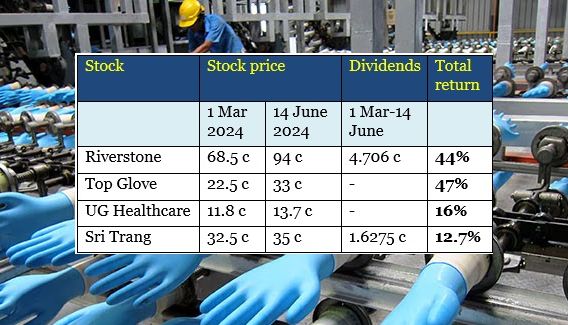• Glove producers are seeing brighter days ahead as the overstocking of healthcare gloves in the market during the pandemic works itself down. In anticipation, investors have bought up their stock. Their price performance has ranged from 13% to 47% since March:  • Way before the current run-up in stock prices, Riverstone has been an outperformer in its industry. Reason: In addition to healthcare gloves, it produces the higher-margin gloves for use in the cleanrooms of electronics and semiconductor companies. (See: Riverstone's 1Q profit surged 55%. It continues to outshine its peers and it's got momentum). In fact, Riverstone previously said it has an approximately 40% world market share for cleanroom nitrile gloves. It has <2% for healthcare gloves, a segment that has way many more producers. Riverstone's Malaysian-listed peers have not penetrated the cleanroom glove market in a big way, if at all. The barriers to entry include a higher level of customization and technical expertise. • As phone and computer sales make a cyclical recovery from 2024, and gets a further boost from AI-enabled devices, Riverstone's cleanroom gloves are expected to be in greater demand. • For more on the glove sector outlook, read UOB KH's recent report below (which is limited to coverage of producers listed on Bursa Malaysia) ..... |
Excerpts from UOB KH report
Analyst: Jacky Goh
We have also observed a feasible trend of improving operating statistics from the past few quarters. With this and the US’ precipitous tariff hike on China’s medical-grade gloves beginning 2026, we re-affirm our optimism that potential valuation re-rating may continue to catalyse the sector’s positive share price trajectories. Maintain OVERWEIGHT. |
| • Industry prospects charting a new beginning. |
After a bleak period of eclipsing earnings and moderating demand from pandemic high in 2021-23, we re-affirm our view that the industry course is altering towards greener pasture in 2024-25.
Our optimism lays on:
| a) intensifying demand from customers on restocking cycle, b) margin expansion on better efficiency and supply rationalisation, c) ASP upcycle across major manufacturers, and d) stabilising input costs. |
Against these backdrops, we anticipate that the domestic gloves companies under our coverage will deliver sequentially stronger earnings in 2024-25.
| • Sustained signs of restocking cycle. |
To recall, an estimated 131b pieces of gloves were overstocked during the pandemic. To add on, various new entrants made a foray into the sector during the pandemic period to capitalise on the glove boom.
Some of these new entrants were then forced to clear inventory and sell their stockpiles at a steep bargain before exiting the market, dragging industry-wide ASPs lower.
We think that these excess stocks have shown signs of nearing depletion, given that distributors are now replenishing inventories with a longer lead time of about two months, recovering towards pre-pandemic's 5-6 months average.
| • ASP revision across regional players continues to be a trend. |
Over the past three quarters, Malaysian glove producers indicated that any ASP revision done was mainly mirroring cost pass through and have faced resistances from end customers to a certain extent.
That said, we gathered that several major China producers have finally raised ASPs from US$15/'000 pieces previously to about US$17/'000 pieces (+13%) in respective May/Jun 24 orders, while domestic producers have also followed suit.
The beginning of this ASP hike cycle marks the eclipse of a persisted price war in the past two years as the industry progressively reverses its earlier oversupply state.
| • US tariff hike remains a cherry on the cake… |
The 25% tariff hike on China medical-grade gloves is set to solidify the Malaysian glove industry's market leader position and allay earlier concerns on market share losses to China producers due to stiff competition.
| "With a 25% tariff imposed on estimated China gloves ASP of US$19-20/'000 pcs by 2026 (current ASP: US$17), Malaysian glovemakers are likely able to command ASPs of US$24-25/'000 pcs while maintaining optimal utilisation rate of >90%. This may allow profitability and margin to surpass prepandemic's level in 2026." |
More crucially, we do not rule out possibilities of further detrimental policies from US towards China's exports.
To note, nine out of 10 US FDA import alerts on glove products ytd are on China exporters.
In conclusion, we think that any deterioration of US-China geopolitical tension may lead to tremendous orderbooks flowing back to domestic glove manufacturers.
| • …converting nitrile gloves' demand landscape. |
Since the COVID-19 pandemic, China glovemakers ramped up capacity at a considerably aggressive pace and leveraged on their lower production costs to seize market shares.
To note, China has significantly raised its global market share from around 11% in 2019 to >30% in 2023.
With a 25% tariff imposed on estimated China gloves ASP of US$19-20/'000 pcs by 2026 (current ASP: US$17), Malaysian glovemakers are likely able to command ASPs of US$24-25/'000 pcs while maintaining optimal utilisation rate of >90%. This may allow profitability and margin to surpass prepandemic's level in 2026.
| • Sector valuations offer palatable upside based on 2025 valuations. |
Glove companies under our coverage still potentially offer palatable capital upside opportunities based on +0.5SD above mean PE of 2025's normalised earnings, which we think reasonable as the sector's valuation re-rates.
Our assessment reveals that Harta, Top Glove and Kossan still offer 9-10% capital upside from current share price based on 2025's normalised earnings.
Full report here




